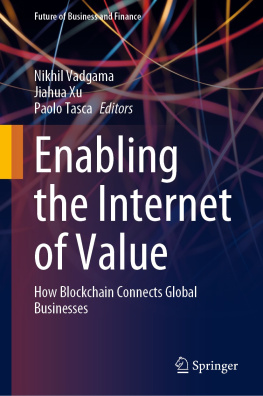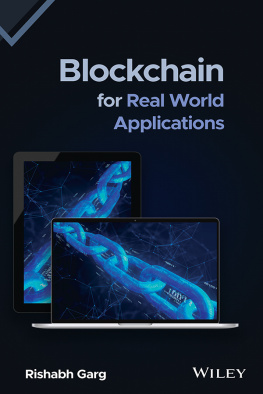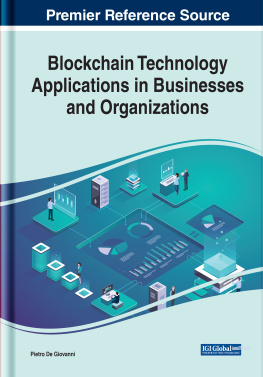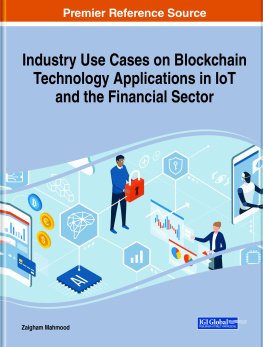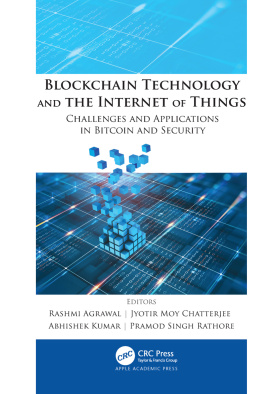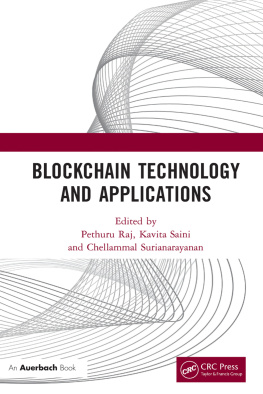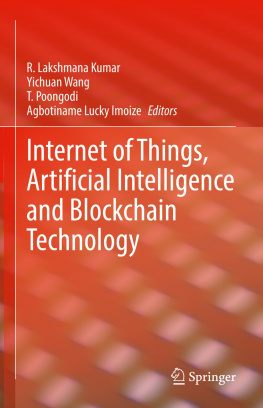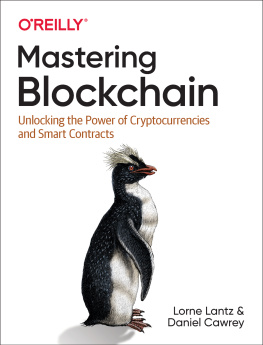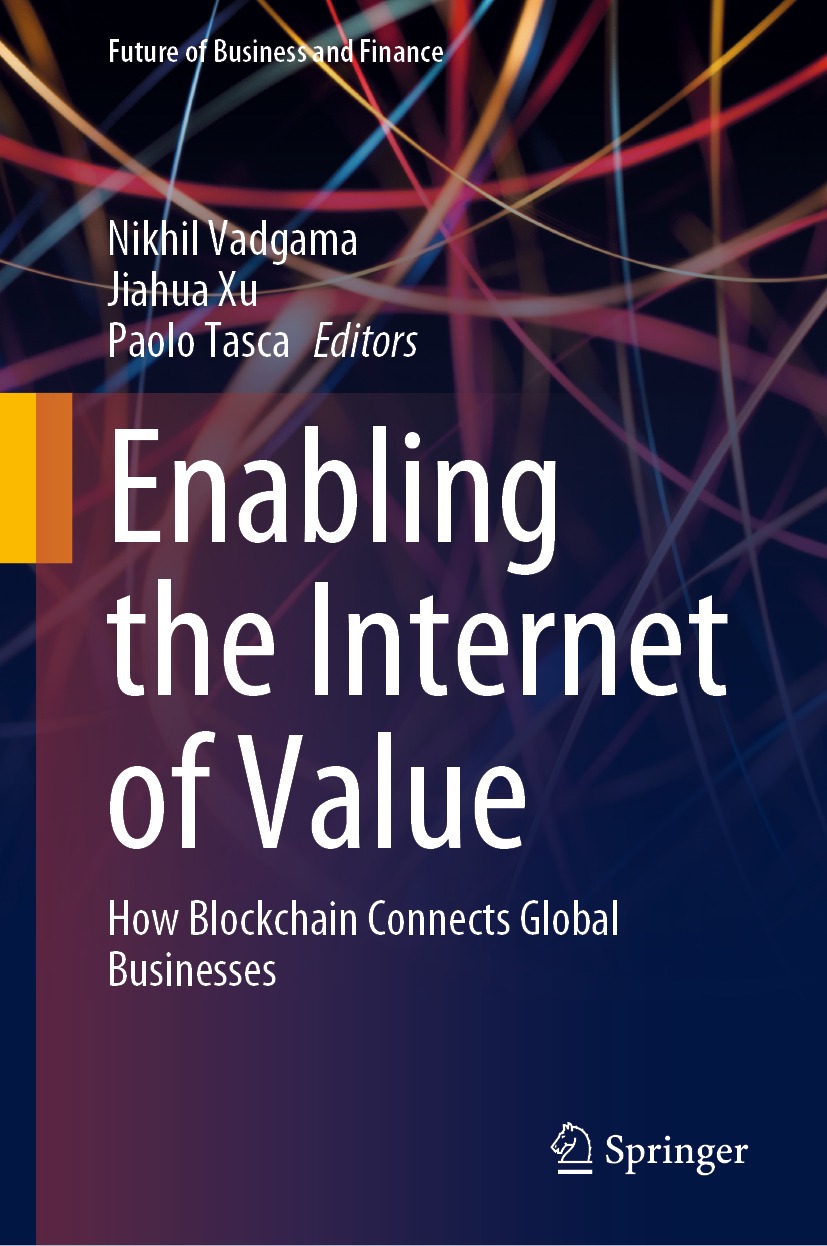Future of Business and Finance
The Future of Business and Finance book series features professional works aimed at defining, describing and charting the future trends in these fields. The focus is mainly on strategic directions, technological advances, challenges and solutions which may affect the way we do business tomorrow, including the future of sustainability and governance practices. Mainly written by practitioners, consultants and academic thinkers, the books are intended to spark and inform further discussions and developments.
More information about this series at https://link.springer.com/bookseries/16360
Editors
Nikhil Vadgama
Centre for Blockchain Technologies, University College London, London, UK
Jiahua Xu
Centre for Blockchain Technologies, University College London, London, UK
Paolo Tasca
Centre for Blockchain Technologies, University College London, London, UK
ISSN 2662-2467 e-ISSN 2662-2475
Future of Business and Finance
ISBN 978-3-030-78183-5 e-ISBN 978-3-030-78184-2
https://doi.org/10.1007/978-3-030-78184-2
The Editor(s) (if applicable) and The Author(s), under exclusive license to Springer Nature Switzerland AG 2022
This work is subject to copyright. All rights are solely and exclusively licensed by the Publisher, whether the whole or part of the material is concerned, specifically the rights of translation, reprinting, reuse of illustrations, recitation, broadcasting, reproduction on microfilms or in any other physical way, and transmission or information storage and retrieval, electronic adaptation, computer software, or by similar or dissimilar methodology now known or hereafter developed.
The use of general descriptive names, registered names, trademarks, service marks, etc. in this publication does not imply, even in the absence of a specific statement, that such names are exempt from the relevant protective laws and regulations and therefore free for general use.
The publisher, the authors and the editors are safe to assume that the advice and information in this book are believed to be true and accurate at the date of publication. Neither the publisher nor the authors or the editors give a warranty, expressed or implied, with respect to the material contained herein or for any errors or omissions that may have been made. The publisher remains neutral with regard to jurisdictional claims in published maps and institutional affiliations.
Disclaimer: Many different authors have written the chapters in this publication. The authors declare under their own responsibility that their manuscripts are original and have not been published previously or, if published, have been authorised for reprint in this book. The opinions expressed and content written in this publication are the responsibility of the authors of the specific chapters (who are named therein) and not those of their respective institutions and the University College London Centre for Blockchain Technologies or the editorial team.
This Springer imprint is published by the registered company Springer Nature Switzerland AG
The registered company address is: Gewerbestrasse 11, 6330 Cham, Switzerland
Foreword
It is easy to imagine one of humankinds earliest transfers of value happening over a campfire on a grassy plain or within a cave offering protection from the elements. One human passing food or clothing to another in exchange for something in kind.
For most of humanitys existence, transactions and the sharing of value were like this: payment delivered at the point of exchange; even long-distance transfers of money often involved the actual unit of value with coins or money crossing bodies of water via ocean liners or miles of the Old West on the backs of ponies. Theres a reason treasure hunters invest huge sums of money to explore ancient shipwrecks as gold coins still lay at the bottom of the sea where they sank in transit.
For centuries, goods, information, and stores of value all travelled in the physical realm, conveyed by people from one destination to another. The advent of the telegram broke that cycle with information able to travel far ahead of individuals. Today, information can bounce electronically around the world in seconds, free to access, and share with no restrictions.
Unfortunately, stores of value even when represented as ones and zeros on an electronic ledger are still subject to outmoded rules of transfer. Unable to move freely, traditional value must stop and start between countries and currencies. Like the hare in its race against the tortoise, speed remains unrealised, instead traveling in fits and starts on its way to its final destination.
This current day, yet thoroughly unmodern, the mismatch between the speed of transit for information, goods, and value persists because todays payment systems were built for yesterdays companies. Todays companies like Amazon, Airbnb, and Uber need to make instant payments to customers, contractors, and small businesses around the world.
On its face, this is impossible because of the patchwork quilt of payment systems that cover the globe, each with distinct rules, processes, and currencies. To compensate, companies and providers must build bridges across these systems manned by payment teams that can sometimes grow to hundreds of employees. And to improve the speed of transactions, each bridge requires pools of money on either end in the local countrys currency to create liquidity.
The end result is an enormous investment of cost and effort that is impossible for small companies or providers to match. This leaves the reality of instant value transfer over the worlds antiquated money networks the domain of only the largest and wealthiest organisations; todays equivalents of the Medici family or other well-known financial brokers of the past.
However, a new reality for value is growing that has the potential to penetrate these walls and deliver a system of value that once again matches the speed at which goods and information can flow.
Blockchain technology allows for trust-minimised systems without central operators, breaking the monopoly of those able to straddle disparate payment networks by virtue of their size and wealth. Paired with digital assets designed for cross-border transactions, blockchain-based systems can deliver instant transfers of value anywhere in the world.
But we are not there yet. There are still missing pieces to the puzzle. Just as you require a specific address to send physical mail, a phone number to call someone, or an email address to send an email, so we all need unique digital wallet identifiers to send point to point value.
And the networks themselves still cannot work seamlessly in conjunction. Payment systems whether traditional or blockchain based have dozens of different methods of integration. We are still missing the Rosetta Stone for value the piece that will make it possible to unify all of these different networks.
In short, we do not yet have our Internet of Value. But we know we need it. And that is progress.

